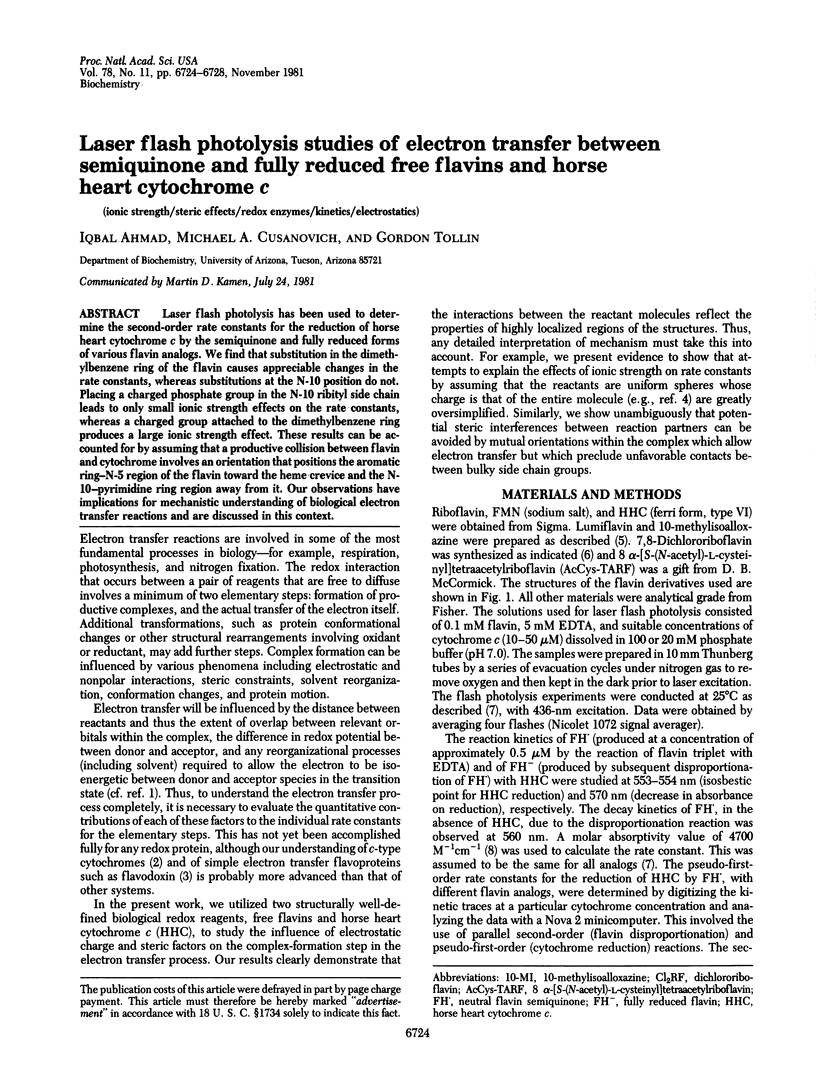Abstract
Laser flash photolysis has been used to determine the second-order rate constants for the reduction of horse heart cytochrome c by the semiquinone and fully reduced forms of various flavin analogs. We find that substitution in the dimethylbenzene ring of the flavin causes appreciable changes in the rate constants, whereas substitutions at the N-10 position do not. Placing a charged phosphate group in the N-10 ribityl side chain leads to only small ionic strength effects on the rate constants, whereas a charged group attached to the dimethylbenzene ring produces a large ionic strength effect. These results can be accounted for by assuming that a productive collision between flavin and cytochrome involves an orientation that positions the aromatic ring--N-5 region of the flavin toward the heme crevice and the N-10--pyrimidine ring region away from it. Our observations have implications for mechanistic understanding of biological electron transfer reactions and are discussed in this context.
Full text
PDF




Selected References
These references are in PubMed. This may not be the complete list of references from this article.
- Ahmed A. J., Millett F. Use of specific lysine modifications to identify the site of reaction between cytochrome c and ferricyanide. J Biol Chem. 1981 Feb 25;256(4):1611–1615. [PubMed] [Google Scholar]
- Edmondson D. E., Singer T. P. Oxidation-reduction properties of the 8 alpha-substituted flavins. J Biol Chem. 1973 Dec 10;248(23):8144–8149. [PubMed] [Google Scholar]
- Ehrenberg A., Müller F., Hemmerich P. Basicity, visible spectra, and electron spin resonance of flavosemiquinone anions. Eur J Biochem. 1967 Oct;2(3):286–293. doi: 10.1111/j.1432-1033.1967.tb00137.x. [DOI] [PubMed] [Google Scholar]
- Ferguson-Miller S., Brautigan D. L., Margoliash E. Definition of cytochrome c binding domains by chemical modification. III. Kinetics of reaction of carboxydinitrophenyl cytochromes c with cytochrome c oxidase. J Biol Chem. 1978 Jan 10;253(1):149–159. [PubMed] [Google Scholar]
- GUZZO A. V., TOLLIN G. ELECTRON PARAMAGNETIC RESONANCE STUDIES OF RIBOFLAVIN AND ITS DERIVATIVES. 3. THE ISOALLOXAZINE SEMIQUINONES AT NEUTRAL AND BASIC PH. Arch Biochem Biophys. 1964 May;105:380–386. doi: 10.1016/0003-9861(64)90022-0. [DOI] [PubMed] [Google Scholar]
- GUZZO A. V., TOLLIN G. ELECTRON PARAMAGNETIC RESONANCE STUDIES OF RIBOFLAVIN AND ITS DERIVATIVES. I. THE ISOALLOXAZINE SEMIQUINONES IN ACID. Arch Biochem Biophys. 1963 Nov;103:231–243. doi: 10.1016/0003-9861(63)90400-4. [DOI] [PubMed] [Google Scholar]
- Goldkorn T., Schejter A. Electrostatic effects on the kinetics of oxidation-reduction reactions of c-type cytochromes. J Biol Chem. 1979 Dec 25;254(24):12562–12566. [PubMed] [Google Scholar]
- Jung J., Tollin G. Transient kinetics of electron-transfer reactions of flavodoxins. Biochemistry. 1981 Sep 1;20(18):5124–5131. doi: 10.1021/bi00521a005. [DOI] [PubMed] [Google Scholar]
- Koppenol W. H. Effect of a molecular dipole on the ionic strength dependence of a biomolecular rate constant. Identification of the site of reaction. Biophys J. 1980 Mar;29(3):493–507. doi: 10.1016/S0006-3495(80)85148-4. [DOI] [PMC free article] [PubMed] [Google Scholar]
- Land E. J., Swallow A. J. One-electron reactions in biochemical systems as studied by pulse radiolysis. II. Riboflavin. Biochemistry. 1969 May;8(5):2117–2125. doi: 10.1021/bi00833a050. [DOI] [PubMed] [Google Scholar]
- Miller W. G., Cusanovich M. A. Electron transport by C-type cytochromes. I. The reaction of horse heart cytochrome c with anionic reductants. Biophys Struct Mech. 1975 Feb 19;1(2):97–111. [PubMed] [Google Scholar]
- Müller F., Massey V. Flavin-sulfite complexes and their structures. J Biol Chem. 1969 Aug 10;244(15):4007–4016. [PubMed] [Google Scholar]
- Peterman B. F., Morton R. A. The oxidation of ferrocytochrome c in nonbinding buffer. Can J Biochem. 1977 Aug;55(8):796–803. doi: 10.1139/o77-118. [DOI] [PubMed] [Google Scholar]
- Simondsen R. P., Tollin G. Structure-function relations in flavodoxins. Mol Cell Biochem. 1980 Dec 10;33(1-2):13–24. doi: 10.1007/BF00224568. [DOI] [PubMed] [Google Scholar]
- Smith H. T., Staudenmayer N., Millett F. Use of specific lysine modifications to locate the reaction site of cytochrome c with cytochrome oxidase. Biochemistry. 1977 Nov 15;16(23):4971–4974. doi: 10.1021/bi00642a005. [DOI] [PubMed] [Google Scholar]
- Smith M. B., Stonehuerner J., Ahmed A. J., Staudenmayer N., Millett F. Use of specific trifluoroacetylation of lysine residues in cytochrome c to study the reaction with cytochrome b5, cytochrome c1, and cytochrome oxidase. Biochim Biophys Acta. 1980 Sep 5;592(2):303–313. doi: 10.1016/0005-2728(80)90191-7. [DOI] [PubMed] [Google Scholar]
- Speck S. H., Ferguson-Miller S., Osheroff N., Margoliash E. Definition of cytochrome c binding domains by chemical modification: kinetics of reaction with beef mitochondrial reductase and functional organization of the respiratory chain. Proc Natl Acad Sci U S A. 1979 Jan;76(1):155–159. doi: 10.1073/pnas.76.1.155. [DOI] [PMC free article] [PubMed] [Google Scholar]
- Wherland S., Gray H. B. Metalloprotein electron transfer reactions: analysis of reactivity of horse heart cytochrome c with inorganic complexes. Proc Natl Acad Sci U S A. 1976 Sep;73(9):2950–2954. doi: 10.1073/pnas.73.9.2950. [DOI] [PMC free article] [PubMed] [Google Scholar]


